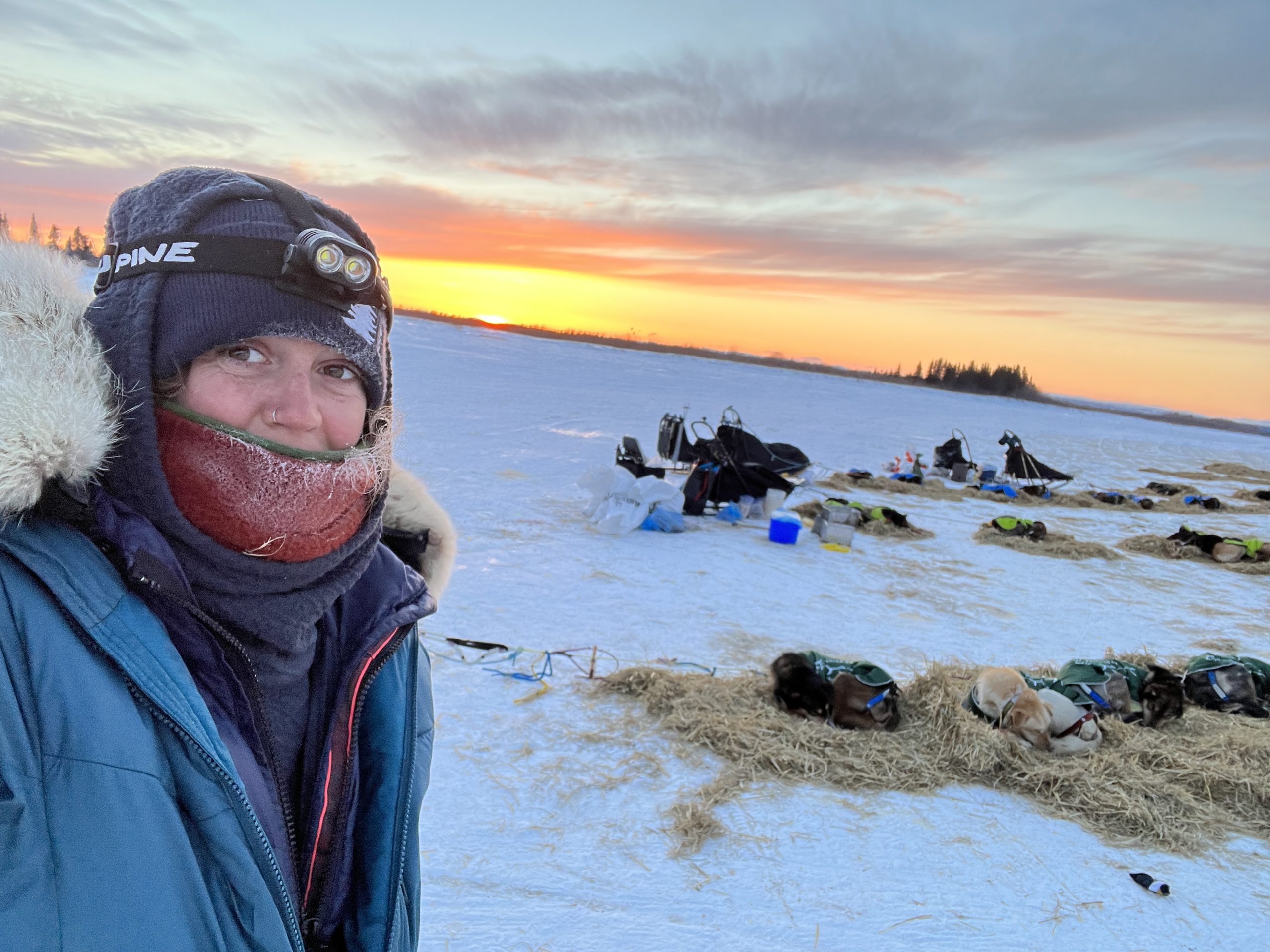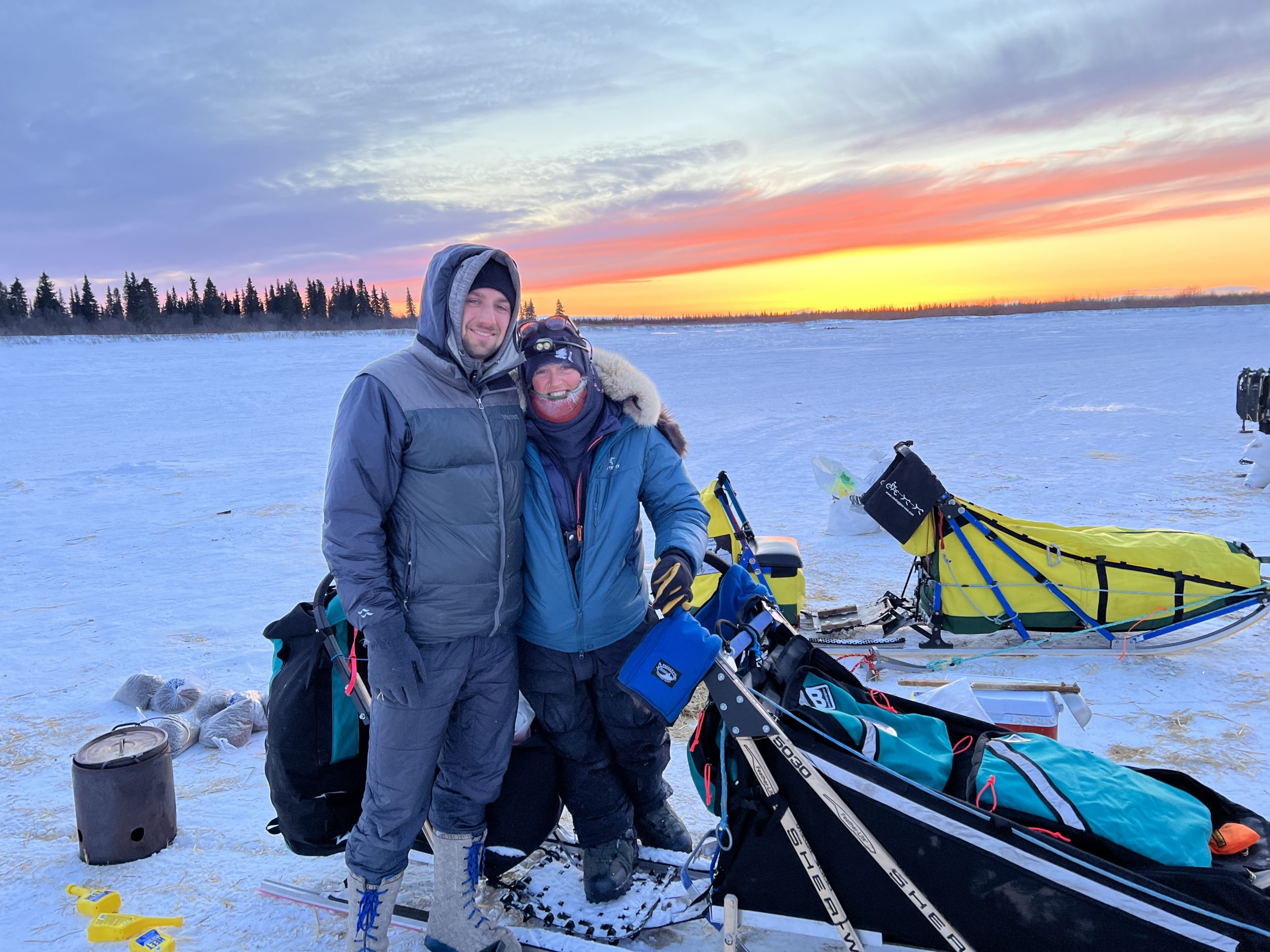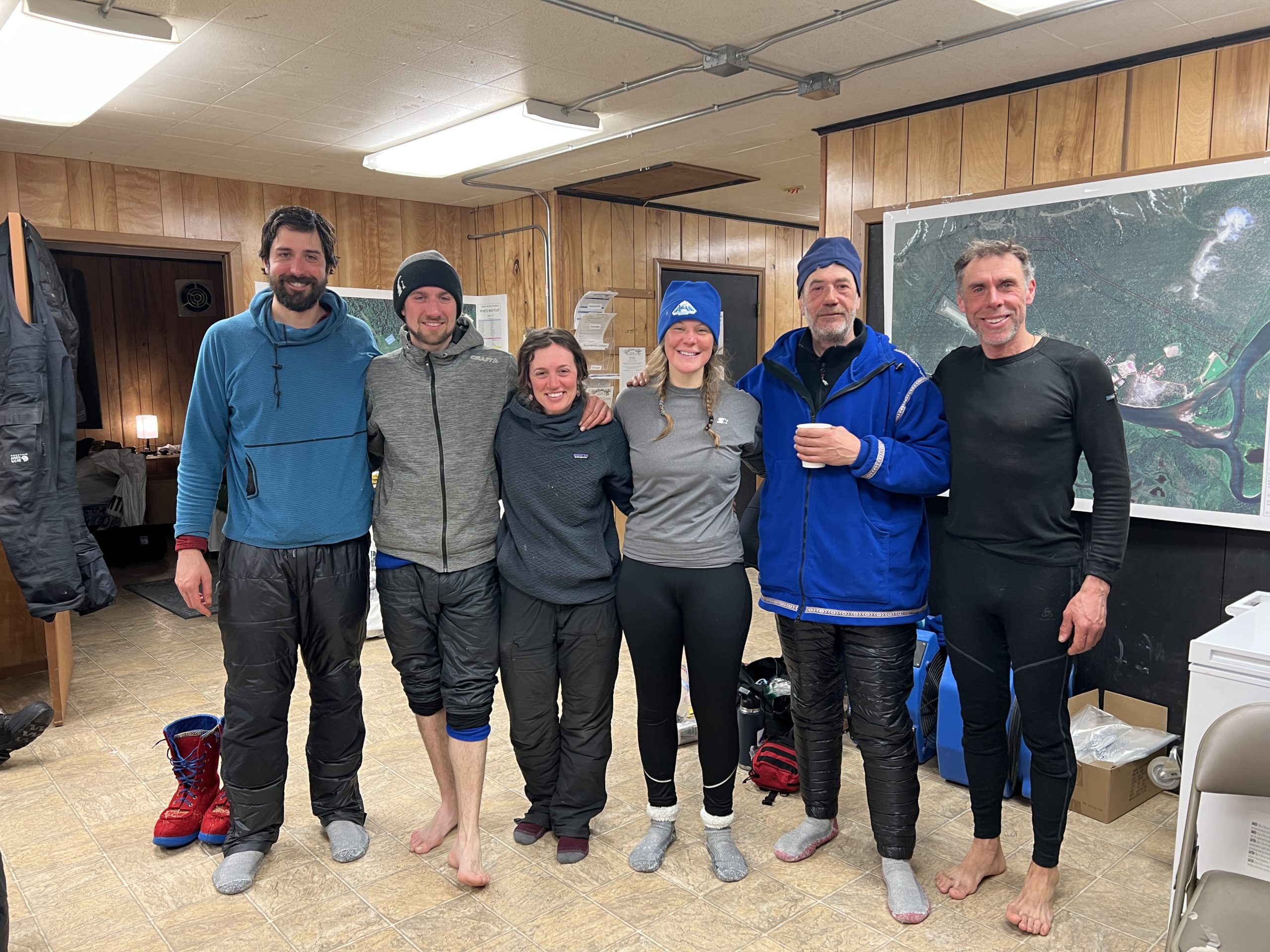Iditarod 2022: Trapped in the Topkok Hills
For most mushers, in most years, White Mountain is the last real checkpoint on the Iditarod trail. Nearly 70 miles from Nome, mushers are required to take a minimum of 8 hours of rest in White Mountain. Once completed, very few teams find it necessary to make another stop in the checkpoint of Safety – just 20 miles from the finish line. When I pulled into White Mountain on Thursday evening, the sun was near to setting, and I told myself that my team needed at least 10 or 12 hours before getting up and making that last long push to Nome. The Coast had been tough for my young group. (“The Coast” refers to the last 250 miles of trail from Unalakleet to Nome, trademarked by its strong winds, sea ice crossings, and hills.) Seven of my nine remaining team members were rookies to this 1,000 mile event, and some had never done a race over 60 miles. While firmly in the “back of the pack,” and generally well-rested after taking many 8+ hour stops in checkpoints, I could see my team was starting to get beat by the strong winds that had plagued us since leaving Shaktoolik.
I told Jeff right away I wanted to take at least 10 hours of rest, and he responded with “Your team isn’t going to get anything more in 10 or 12 than they are going to get in 8.” This is a very old adage in mushing – one that you will hear a lot. But I winced. “You know,” I said, “If I take more than 8, then I get more sleep, too! That’s something.” Jeff couldn’t argue with me there. But we did the math, and realized that if we left after only 8 hours of rest, that would put us into Nome in the early afternoon on Friday. This meant we could mostly avoid mushing during the hottest part of the day (approximately 12 pm to 4 pm), which was fresh on our minds after an extremely warm mid-day run leaving Elim. I told Jeff I was concerned that my leaders couldn’t handle any more brutal wind, so we planned for our teams to stay tight together on this final run to the finish line, essentially using his team to lead mine. Before heading into the checkpoint building to get some shut-eye, Jeff pointed to the Topkok Hills in the distance. “See that?” he said. I did. The peaks appeared fuzzy, and blown out to the side. This is what strong winds look like on mountain tops. “Yikes,” I said. “It’s windy up there.” Then we went inside. We ate some food, set our alarms for 1:00 am, and forgot that conversation about wind in the mountains ever happened.

Before I go on, let me stop here and point out some of the major mistakes that I made up to this point. They are easy to see now in hindsight, and also now that I’m well rested… First off, I should have accepted the leader problems I was having, and taken them more seriously. Maybe a 10 or 12 hour rest wouldn’t have “fixed” my problems, but then again, maybe it would have. Or perhaps I should have taken that 10 or 12 hour rest several checkpoints ago. There was a whole group of mushers still about a day behind me, so I had no fear of being ejected from the race for being “too slow” (as does sometimes happen to pokey racers).
Mistake #2: Jeff and I hardly ever train together – let alone race together – because we don’t run at the same pace. Jeff is always, consistently faster than me. He’s got the better, stronger dogs in our kennel, and he just naturally likes to move faster, taking fewer and shorter stops, and demanding a higher level of performance from his team. We only happened to be together in White Mountain because he had been making a persistent effort to stay with me. After several injuries to key dogs early on in Jeff’s race, he decided to stay behind in the checkpoint of Cripple and wait for me to catch up to him. But upon leaving Cripple we found we just couldn’t stay together. We quickly separated on long hill climbs, and I routinely stopped to take pictures or adjust my clothing. Eventually we adopted a rhythm in which we’d leave checkpoints together, but each move at our own pace along the trail. Even though we left Elim together, Jeff got into White Mountain over an hour ahead of me. For us to plan to “stay together” on this last run to Nome should have been inconceivable.

Finally, we saw the wind blowing in the mountains! If I had it to do over, I would have, at the very least, noticed the wind that night and said, “We should stay here until daylight to make sure it’s not still blowing like that when we go to leave.” Duh.
Our last fatal mistake would come upon waking. I was first out to the dog yard, although there was a group of six of us all planning to leave around the same time. I heated water for the dogs, prepared their last meal, packed my sled, and assessed a couple of dogs who had come into the checkpoint with some small orthopedic issues. Eventually I was joined in the dog yard by Bridgett, Sean, Sebastian, Gerhardt, and Jeff. We all attended to our sleds and our teams. During this time I do not recall seeing any race personnel other than a vet or two, and a woman with a clipboard who told us our official “out” times. While I didn’t consciously consider it at the time, I guess I had always assumed that if there were some kind of extreme weather event up ahead on the trail that race personnel would let mushers know that. But of the very few people up and about at 3:00 am, none of them said anything about weather or trail conditions, and I didn’t ask. Later on Bridgett Watkins would tell me that she did get a weather report from her husband via satellite phone for Safety, and that there was nothing serious to report. But there is likely a reason they call that place Safety – because it’s a whole hell of a lot safer than all the crazy shit that comes before it. The Topkok Hills and the two blowholes below them don’t have weather stations. This is some seriously remote country, with no human inhabitants and perhaps most of the time, no need for real-time weather forecasting.

In addition to a weather forecast that may or may not have existed, there would have been other indicators that morning, too. Riley Dyche left White Mountain the previous evening, just as I was arriving. That morning, as I was doing my chores, I could have asked race personnel to see Riley’s online GPS tracker. Did he make it through the Topkoks, which were so windy the night before? Did he make it through the notorious blowhole between the Topkoks and Safety? Had I been able to replay his tracker, I would have watched Riley struggle to make it through the Topkoks. Stopping and restarting, and finally shutting down in the Topkok shelter cabin, between the hills and the blowhole… I would have seen that it took Riley five and a half hours to cover a distance that normally only takes three.
With all of these mistakes now made, Jeff and I departed White Mountain around 3:30 am into an immediately strong wind. Right away I had doubts about our plan to stay together as I could feel Jeff’s team quickly moving away from me. At the same time, I saw that Chippewa was not going to be able to stay in lead with Knox. He threw me glances over his shoulder, and basically stopped pulling altogether. On this race Chippewa had proved to be a brilliant and trustworthy leader on ice or deep snow – even preferring to run alone in those conditions – but he was not one to face the wind. So I tried my other go-to leader, Jae Bird, who along with Knox, had taken me from Shaktoolik to Koyuk, and through Golovin – some seriously windy sections. But she had had enough. She would go – but not in lead. With Jeff now out of sight, I made another stop to put Yentna in lead. Unlike Chippewa and Bird, Yentna had not done much leading so far on the race, but she had done a great job leading with Knox through a wind storm between Koyuk and Elim. Some dogs just like a challenge. I put Yentna with Knox and we were off! I was relieved. The cross-wind became stronger and stronger, but the terrain was flat and so far I was still able to see the trail and at least one trail markers ahead. However, the blowing snow was starting to sting my eyes, and I struggled to find a way to position my fur ruff so that it didn’t crowd my face and block my vision. Eventually I caught up to Jeff who had stopped to wait for me. I told him about my leader troubles, and reminded him we needed to stay together – especially if this wind was going to keep up. He yelled over the wind: “In my experience, this flat section out of White Mountain is sometimes the worst. We may climb into the hills now and it will get better all of a sudden.” Looking back, this is the point at which I may have turned around and returned to White Mountain, had Jeff not been with me. But he was, and I didn’t. And hindsight is 20/20.
Conditions did not improve. As we climbed, the winds became unbearably strong. The trail began to tilt on its side – no longer flat, but now side-sloped, and also icy from the warm days of this year’s early spring. I eventually opted for wind burn and frost bite on my face as opposed to fighting my billowing fur ruff. I had to see, God damn it. At one point Jeff stopped, walked back to my sled and gave me a double high-five: “OK! This is now the most challenging mushing I’ve ever done!!” He was stoked. I was … terrified. But his confidence gave me strength, and I loved seeing him having fun – especially when I knew his race hadn’t gone as he had planned. I was happy for him, even though I was now totally out of my own comfort zone. But we were also still managing to keep our teams together, so I also told myself “If he can do it, I can do it.”
Perhaps my first real moment of doubt about our ability to complete our run to Nome came upon crossing a frozen creek. The ice was glass – no traction at all for the dogs. Jeff’s timing was perfect. His team and sled hit the ice at the same time that a particularly giant wind gust came up. It sent him sailing sideways, knocking his sled and body down onto the ice. Later he would tell me that in his mind’s eye he saw the entire team and himself flying down the frozen creek, propelled by an unstoppable wind; too far off the trail to ever be recovered. Ironically this is almost exactly what would happen to Gerhardt Thiart soon after we made it through. Somehow I crossed the ice sheet with more grace – unscathed. But that was only luck. For sure, I thought, there would be more of this to come.
The run through the Topkok Hills soon became a series of big climbs and little drops. A sort of “three steps forward and one step back.” Overall we were gaining in elevation, with the winds ever increasing, and the challenge of the trail becoming surreal. Like many alpine trails, the Iditarod trail in the Topkoks transects the sides of the peaks. This means the trail is not flat or level beneath your runners, but instead, is “side sloped” as it runs along the sides of the mountains. In addition to the general annoyance of being on a side-sloped trail, this particular trail had also been baked in the heat and sun of an early spring, and conditions were extremely icy. Instead of our sled runners biting into soft snow and allowing us to hold the side of the mountain, we were instead on giant skating rink, tilted on its side as if in one of those horrific “fun houses.”
Jeff and I were now fully immersed in a world dominated by icy, side-sloped trail combined with 80 mph winds and so much blowing snow that we could barely see our lead dogs – small though our teams were. At one point I could only see my single wheel dog, Whiskey, and the trail beneath my runners. Suddenly though it occurred to me that we were no longer following any sled tracks. The snow beneath us was unmarked; my dogs had veered up hill and off the trail! Whether in search of better (less icy) footing, or just truly disoriented, I didn’t know, but I was forced to call my leaders back down to the dangerously icy, marked trail for fear of getting lost otherwise. Realizing their vision may be impaired (as mine was) by the blowing snow, I stopped the team and walked up to my leaders. Sure enough, their eyes were mere slits. The blowing snow was engulfing their heads, and the heat of their bodies and breath was instantly melting it, turning it to ice. I took my glove off and scraped the ice away from their eyes and noses. This was no longer just “out of my comfort zone.” This was insanity.
[Side note: Brent Sass experienced similar conditions while mushing through this same section of trail several days before us. Warning: The videos he shared in this article have been described by many dog mushers as being “too much.”]
